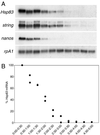Spatial and temporal control of RNA stability
- PMID: 11416182
- PMCID: PMC34617
- DOI: 10.1073/pnas.111145698
Spatial and temporal control of RNA stability
Abstract
Maternally encoded RNAs and proteins program the early development of all animals. A subset of the maternal transcripts is eliminated from the embryo before the midblastula transition. In certain cases, transcripts are protected from degradation in a subregion of the embryonic cytoplasm, thus resulting in transcript localization. Maternal factors are sufficient for both the degradation and protection components of transcript localization. Cis-acting elements in the RNAs convert transcripts progressively (i) from inherently stable to unstable and (ii) from uniformly degraded to locally protected. Similar mechanisms are likely to act later in development to restrict certain classes of transcripts to particular cell types within somatic cell lineages. Functions of transcript degradation and protection are discussed.
Figures






References
-
- Davidson E H. Gene Activity in Early Development. Orlando, FL: Academic; 1986.
-
- Davidson E H, Hough B R. J Mol Biol. 1971;56:491–506. - PubMed
-
- Hough-Evans B R, Wold B J, Ernst S G, Britten R J, Davidson E H. Dev Biol. 1977;60:258–277. - PubMed
-
- Rubin G M, Hong L, Brokstein P, Evans-Holm M, Frise E, Stapleton M, Harvey D A. Science. 2000;287:2222–2224. - PubMed
Publication types
MeSH terms
Substances
LinkOut - more resources
Full Text Sources
Other Literature Sources
Molecular Biology Databases

